Helium Market Research, 2032
The global helium market size was valued at $3.3 billion in 2022, and is projected to reach $4.9 billion by 2032, growing at a CAGR of 4.2% from 2023 to 2032. Helium market is primarily driven by advancements in technology. One of the primary areas where Helium's role has become increasingly critical is in medical imaging, particularly Magnetic Resonance Imaging (MRI) machines. Helium is used to cool the superconducting magnets in MRI machines, which are essential for their operation. There is an increase in the demand for Helium, with expansion of the healthcare industry and surge in the demand for diagnostic imaging. This trend is further amplified by the increasing prevalence of chronic diseases and the need for advanced medical technologies.
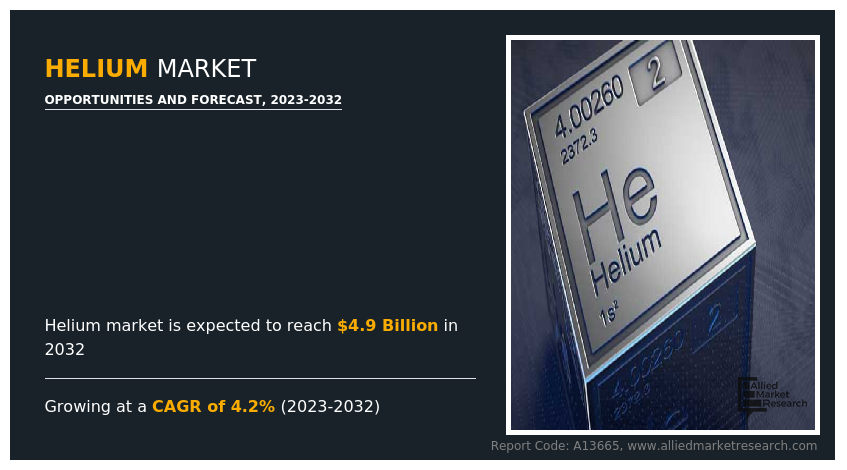
Introduction
Helium is characterized by its low boiling point, which is the lowest among all elements. One of the most significant applications of helium is in the field of cryogenics. It is used as a coolant in superconducting magnets, which are essential for magnetic resonance imaging (MRI) machines and particle accelerators. Its low boiling point allows it to maintain superconducting materials at temperatures close to absolute zero. This property is critical for the operation of high-energy physics experiments, such as those conducted at the Large Hadron Collider (LHC). Helium's role in these technologies supports advancements in medical imaging, scientific research, and various other high-tech fields.
In aerospace applications, Helium is used to pressurize and purge rocket fuel tanks, as it is a non-reactive and lighter alternative to other gases. Its low density and inert nature make it suitable for this purpose, as it prevents reactions that could compromise the integrity of fuel systems. In addition, it is used in the testing of spacecraft and other aerospace equipment. Its use in these domains ensures the safe and efficient operation of space exploration technologies and contributes to the advancement of aerospace engineering.
Its most visible application is in ballooning and airships. It is used to fill balloons and blimps due to its lighter-than-air properties and non-flammable nature. Helium provides a safer alternative, unlike hydrogen, which was historically used for similar purposes but poses significant flammability risks. Helium-filled balloons are commonly used for recreational purposes, scientific experiments, and promotional activities. Its use in airships is more specialized but contributes to various commercial and observational tasks.
Key Takeaways
The helium market study covers 20 countries. The research includes a segment analysis of each country in terms of both value ($million) and volume (million cubic feet) for the projected period 2023-2032.
The study integrated high-quality data, professional opinions and analysis, and critical independent perspectives. The research approach is intended to provide a balanced view of global markets and to assist stakeholders in making educated decisions in order to achieve their most ambitious growth objectives.
Over 3,700 product literatures, annual reports, industry statements, and other comparable materials from major industry participants were reviewed to gain a better understanding of the helium market.
The helium market is highly fragmented, with several players including Air Liquide S.A., Air Products & Chemicals Inc., ExxonMobil Corporation, Gazprom PJSC, Gulf Cryo S.A.L., IACX Energy, Linde plc, Matheson Tri-Gas, Inc., Praxair, Inc., and Taiyo Nippon Sanso Corporation. Also tracked key strategies such as acquisitions, product launches, mergers, expansion etc. of the players operating in the helium market.
Market Dynamics
Increase in demand for cooling superconducting magnets in rocket engines and space telescopes is expected to drive the growth of Helium market during the forecast period. The growing aerospace industry significantly impacts the demand for Helium, primarily due to its critical role in cooling superconducting magnets used in rocket engines and space telescopes. In aerospace applications, Helium is prized for its unique properties—particularly its low boiling point and inert nature. These characteristics make it an ideal coolant for superconducting magnets, which are crucial for various high-tech aerospace systems.
In rocket propulsion systems, superconducting magnets are used to manage complex cooling requirements of rocket engines. These magnets need to operate at extremely low temperatures to maintain their superconducting state, and Helium serves as an efficient coolant to achieve the same. The demand for Helium to support these sophisticated technologies is expected to increase as the aerospace industry advances with more ambitious space missions and the development of next-generation rockets. In October 2023, the Indian Space Association (ISpA) and the French aerospace industry organization GIFAS signed a Memorandum of Understanding to strengthen their collaboration in the space sector. This agreement aims to improve the understanding of each country’s space industry capabilities and raise awareness of business opportunities in the space domain. The Helium market is expected to witness growth with developments in the space industry.
However, limited supply of helium is expected to restrain the growth of the Helium during the forecast period. Helium's limited supply presents a significant challenge to the market, primarily due to its status as a finite resource and the concentration of its extraction and production in a few key regions. Helium is a rare gas found in trace amounts within natural gas deposits, and its extraction requires specialized techniques that are both complex and costly. As a result, Helium production is largely concentrated in a handful of countries, such as the U.S., Qatar, and Russia, where substantial natural gas reserves containing helium are located. This geographic concentration of production facilities means that any disruptions in these regions—whether due to geopolitical issues, natural disasters, or operational challenges—can significantly impact the global supply of Helium. For instance, political instability or regulatory changes in major Helium-producing countries can lead to supply constraints, affecting the availability of Helium for various industries.
Segment Overview:
The helium market is segmented into type, application, end-use industry, and regions. On the basis of phase type, the helium market is bifurcated into liquid and gaseous. On the basis of application, the helium market is categorized into cryogenics, pressurizing and purging, welding, controlled atmosphere, leak detection, breathing mixture, others. On the basis of the end-use industry, the helium market is divided into aerospace and defense, medical and healthcare, electricals and electronics, and others. Region-wise, the helium market is studied across North America, Europe, Asia-Pacific, and LAMEA.
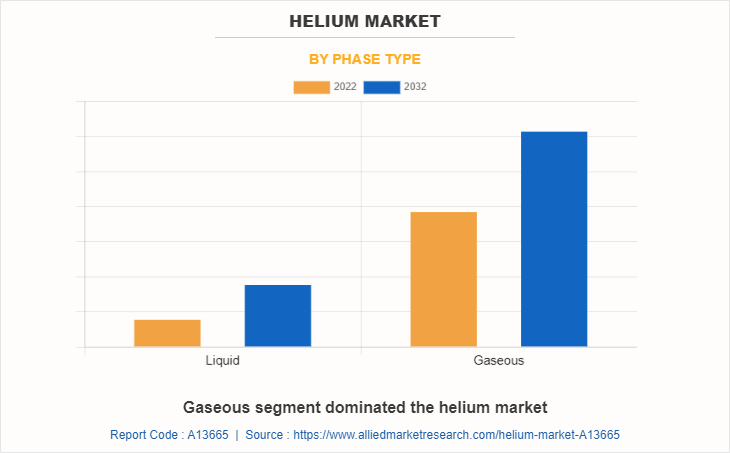
Helium gas serves important roles in different industries, including technology, science, medicine, and manufacturing. In welding processes like TIG and MIG welding, helium acts as a shielding gas, safeguarding the weld area from oxidation and contamination. This ensures high-quality welds. In diving applications, helium-oxygen mixtures like heliox and trimix are used for deep-sea and saturation diving. The low density of helium minimizes the narcotic effects of breathing gases at high pressures, preventing conditions like nitrogen narcosis. One of the most well-known uses of helium gas is filling balloons to make them float. Helium is lighter than air and provides buoyancy, allowing balloons to rise and float in the atmosphere.
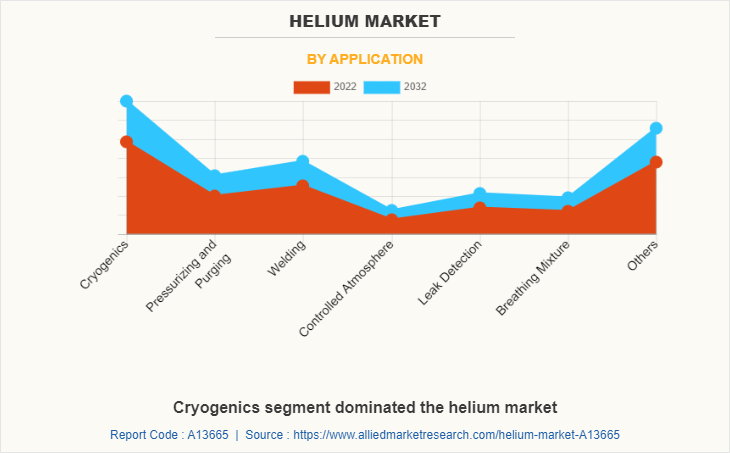
On the basis of application, the cryogenics segment dominated the helium market representing the CAGR of 3.7% during the forecast period. Helium plays a crucial role in various scientific applications that require extremely low temperatures. One important use of helium is in the long-term storage of biological samples like eggs, embryos, and tissue. By creating and maintaining cryogenic temperatures, helium enables the preservation of these samples for medical research, assisted reproduction, and the conservation of genetic diversity.
Additionally, helium finds extensive usage in scientific research fields such as low-temperature physics, materials science, and condensed matter physics. Researchers leverage helium to study the behavior of materials at ultra-low temperatures, uncovering unique properties and phenomena that would otherwise remain elusive. To achieve these extremely cold temperatures, helium is essential in cryostats and dilution refrigerators, providing the means to reach and maintain the desired conditions. This capability opens up avenues for exploring the frontiers of science, enabling advancements in various fields through the investigation of materials and the discovery of novel scientific insights.
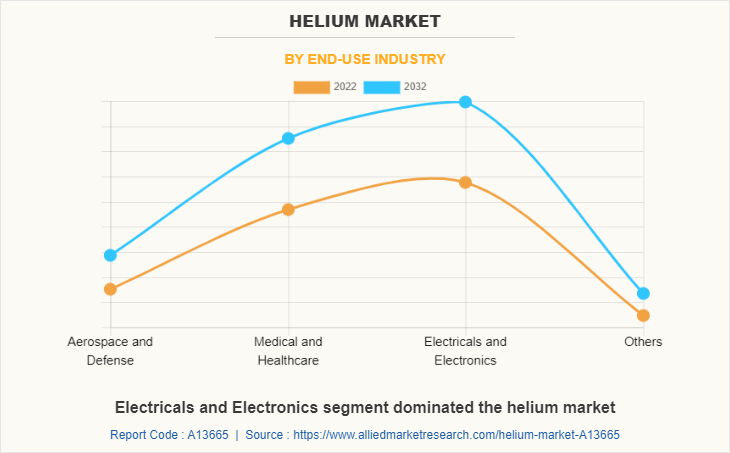
Based on end-use industry, the electricals and electronics segment held the highest revenue and is expected to experience a substantial growth of 3.2% CAGR during the forecast period. Helium is commonly used as a coolant in various electronic and electrical systems. Superconducting magnets in devices such as magnetic resonance imaging (MRI) machines, particle accelerators, and some scientific research equipment require extremely low temperatures. Helium is employed as a cryogenic coolant to achieve these low temperatures. Helium is used as a tracer gas to detect leaks in electronic and electrical systems. It is an inert gas that can be easily detected using sensitive helium leak detectors. This method is particularly useful in identifying leaks in systems such as air conditioning, refrigeration, and vacuum systems.
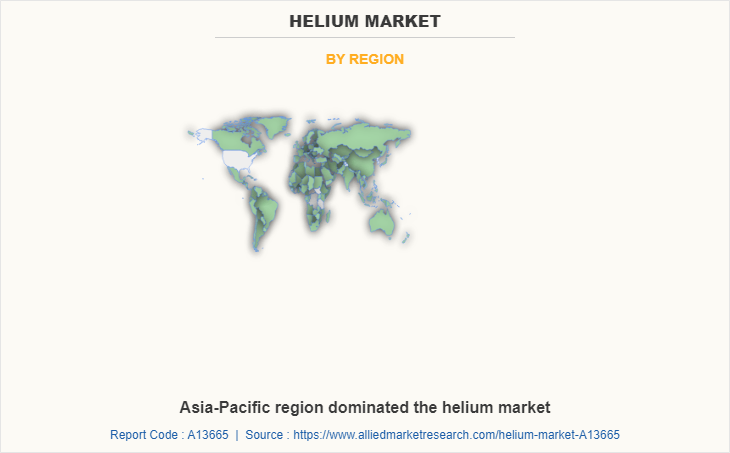
The Asia-Pacific region stands at the forefront of research and development in the fields of cryogenics and superconductivity. Helium serves as a crucial cryogenic coolant in a wide range of applications, including superconducting magnets, MRI machines, particle accelerators, and nuclear magnetic resonance (NMR) spectrometers. These advanced technologies have widespread applications in scientific research, healthcare, and materials science.
Furthermore, the Asia-Pacific region has emerged as a leader in the electronics and semiconductor manufacturing industries, where the presence of helium plays a vital role in ensuring stability and reliability across various processes. Helium is particularly significant in cooling superconducting magnets in MRI machines, manufacturing fiber optics, and purging contaminants from electronic components during assembly.
Competitive Analysis:
The major players operating in the global helium market include Air Liquide S.A., Air Products & Chemicals Inc., ExxonMobil Corporation, Gazprom PJSC, Gulf Cryo S.A.L., IACX Energy, Linde plc, Matheson Tri-Gas, Inc., Praxair, Inc., and Taiyo Nippon Sanso Corporation.
In July 2024, European Organization for Nuclear Research (CERN) completed the installation of four large helium tanks for the High-Luminosity LHC (HL-LHC). Two tanks were installed at Point 1 in June, and two more were positioned at Point 5 in July. These tanks are essential for storing helium to power the refrigerators that will cool the HL-LHC’s new focusing magnets adjacent to the ATLAS and CMS experiments. Each tank, manufactured in Portugal, is 28 meters long, 3.5 meters in diameter, and weighs over 62 tons. They have a storage capacity of 250 cubic meters of gaseous helium at 20 bars pressure, which equates to approximately 800 kg of helium. The transport of these tanks to CERN was a significant logistical operation, taking over eight days due to their size.
Historical Trends of Helium:
In 1868 French astronomer Pierre Janssen and English astronomer Norman Lockyer independently observe a yellow line in the solar spectrum during a solar eclipse. They attribute this line to a new element, which they named helium after the Greek word "helios" meaning the sun.
In 1903 The U.S. becomes the world's leading producer of helium when large reserves are found in natural gas fields in Kansas. Helium extraction begins in earnest, and the U.S. establishes a strategic helium reserve.
1908: Dutch physicist Heike Kamerlingh Onnes successfully liquefies helium for the first time. He achieves this by subjecting helium gas to extremely low temperatures, reaching just a few degrees above absolute zero (-273.15 degrees Celsius or -459.67 degrees Fahrenheit). He successfully liquefies helium by cooling it to extremely low temperatures.
In 1881 Italian physicist Luigi Palmieri detected helium on Earth for the first time through its D3 spectral line, when he analyzed a material that had been sublimated during a recent eruption of Mount Vesuvius.
The Helium Privatization Act of 1996 mandated the U.S. government to sell a large portion of the National Helium Reserve. However, the law faced criticism as the formula-based sale price was much lower than the market price of helium, leading to concerns and labeling it as a "fiasco." In 2013, the bill was amended to introduce auctions as a method for selling helium.
In 2020, the sustainability of helium production, supply, and use was assessed using the WORLD7 integrated model. The use of helium is concluded to be unsustainable with respect to long-term supply security, due to the lack of significant recycling.
Technology Trend Analysis:
Helium recovery and purification technologies focus on efficiently extracting helium from natural gas fields, where it is often found in trace amounts. Advanced systems, such as cryogenic separation and pressure swing adsorption, improve helium recovery rates and purify the gas for use in various industries. These innovations help maximize supply, reduce waste, and ensure a more sustainable and cost-effective helium supply, addressing growing demand across sectors such as healthcare, electronics, and aerospace.
Helium plays a crucial role in cryogenic applications, particularly in cooling superconducting magnets used in MRI machines and particle accelerators. As these systems require extremely low temperatures to function, helium’s ability to reach near absolute zero is essential. Ongoing advancements in cryogenic storage and cooling technologies aim to improve efficiency, reduce costs, and enhance the reliability of helium-dependent systems, driving innovation in medical imaging, scientific research, and high-tech industries.
The growing use of helium in quantum computing is driven by its crucial role in cooling quantum processors. Helium, particularly in its liquid form, is used to maintain the extremely low temperatures required for superconducting qubits to function efficiently. As quantum computing continues to advance, the demand for helium increases, driving innovations in its application for cooling systems, while supporting the development of faster and more powerful quantum technologies.
Advancements in helium leak detection technologies have significantly improved safety and efficiency in industries such as semiconductor manufacturing and aerospace. These technologies use highly sensitive instruments, such as mass spectrometers and ultra-sensitive detectors, to identify even the smallest leaks in helium systems. This ensures the proper functioning of critical equipment, minimizes helium wastage, and prevents costly damage or operational disruptions, especially in high-precision applications where helium is essential for cooling and pressurization.
Key Benefits For Stakeholders
- This report provides a quantitative analysis of the market segments, current trends, estimations, and dynamics of the helium market analysis from 2022 to 2032 to identify the prevailing helium market opportunities.
- The market research is offered along with information related to key drivers, restraints, and opportunities.
- Porter's five forces analysis highlights the potency of buyers and suppliers to enable stakeholders make profit-oriented business decisions and strengthen their supplier-buyer network.
- In-depth analysis of the helium market segmentation assists to determine the prevailing market opportunities.
- Major countries in each region are mapped according to their revenue contribution to the global market.
- Market player positioning facilitates benchmarking and provides a clear understanding of the present position of the market players.
- The report includes the analysis of the regional as well as global helium market trends, key players, market segments, application areas, and helium market growth strategies.
Helium Market Report Highlights
| Aspects | Details |
| Market Size By 2032 | USD 4.9 billion |
| Growth Rate | CAGR of 4.2% |
| Forecast period | 2022 - 2032 |
| Report Pages | 300 |
| By Application |
|
| By End-Use Industry |
|
| By Phase Type |
|
| By Region |
|
| Key Market Players | Taiyo Nippon Sanso Corporation, Praxair, Inc., Air Products & Chemicals Inc., Gulf Cryo S.A.L., Air Liquide S.A., Linde plc, IACX Energy, Gazprom PJSC, ExxonMobil Corporation, Matheson Tri-Gas, Inc. |
| | Exxon Mobil Corporation, Air Liquide SA, Messer Group GmbH, PGNiG. |
Analyst Review
According to the opinions of various CXOs of leading companies, the global helium market was dominated by the gaseous segment. Helium gas plays a crucial role in welding procedures, especially for non-ferrous metals like aluminum, where it serves as a shielding gas. Its primary purpose is to safeguard the welding region from impurities, combat oxidation, and improve the overall welding quality. Helium is frequently combined with other gases, and specialized equipment can readily identify its presence, enabling the detection of leaks in systems or containers.
The helium market is driven by rise in demand for helium in the healthcare sector. Helium is a crucial component in the healthcare industry, driven by its various medical applications. One important use is in heliox, a mixture of helium and oxygen, which is utilized in respiratory treatments for conditions such as asthma, Chronic obstructive pulmonary disease (COPD), and upper airway obstruction. The demand for helium in healthcare is further fueled by the rise in prevalence of respiratory diseases and the need for respiratory therapies in developing countries.
However, limited helium reserves are expected to restrain industry expansion. The limited availability of helium, combined with increasing demand from industries such as electronics, aerospace, and healthcare, results in a supply-demand imbalance and higher prices. These rising prices can negatively impact businesses that depend on helium, making it expensive to acquire and potentially affecting their profitability.
The Asia-Pacific region is projected to register robust growth during the forecast period. Helium plays a crucial role in the aerospace and defense sectors across the Asia-Pacific region. Its unique properties, including low density and non-reactivity, make it highly desirable for various applications. One of its primary uses is as a lifting gas in airships and balloons, which are employed for surveillance, research, and communication purposes. Additionally, helium finds extensive utilization in purging and pressurizing fuel tanks and rocket engines. It is also employed as a cooling medium in nuclear reactors.
The leading application of helium market includes cryogenics, pressurizing, and purging, welding, controlled atmosphere, leak detection, breathing mixture, and others.
Air Liquide S.A., Air Products & Chemicals Inc., ExxonMobil Corporation, Gazprom PJSC, Gulf Cryo S.A.L., IACX Energy, Linde plc, Matheson Tri-Gas, Inc., Praxair, Inc., and Taiyo Nippon Sanso Corporation are the top companies to hold the market share in helium.
Advancements in technology with respect to helium and rise in demand for helium in the healthcare sector are the driving factors of the helium market.
Helium recycling and conservation are the upcoming trends of Helium Market in the world
Asia-Pacific is the largest regional market for helium.
The price volatility of helium is the challenge faced by the helium market.
The global helium market was valued at $3.3 billion in 2022, and is projected to reach $4.9 billion by 2032, growing at a CAGR of 4.2% from 2023 to 2032.
Loading Table Of Content...
Loading Research Methodology...



